On Saturday July 28th I took a long drive up to Gilmanton, NH to meet flax dresser Gina Gerhard, and to see a newly excavated historical flax retting pond. Fellow flax aficionado Faith made the long journey, too. Even though it is too late for you to see Gina in Gilmanton, it is not too late for you to enjoy Faith’s absolutely outstanding interactive program about flax at the History Workshop at Historic Deerfield. (12/24/2023 Edited to add that the link to Faith’s flax program no longer works so I deleted it.)
I am not a very ambitious driver, but despite the long haul it was well worth the trip. I met a lot of other flax enthusiasts, including fellow Master Weaver Diane Howe demonstrating her flax spinning skills and beautiful antique wheel. I came back very excited and motivated to persevere with my flax endeavors. This process is so fraught with trial and error, in my case mostly error, that it takes a lot of encouragement to persist. I am very grateful to all the folks in the flax and linen study group I’m part of for constant advice and support.
Gina has a great collection of antique flax tools, and I found it very interesting to see the different styles of scutching blades and hetchels. I found I preferred some tools more than others, and imagine that this must have been true in the past. People must have had their favorite scutching blade or favorite hetchels. It made me wonder about the processes that affect which tools survive to become antiques. Are the ones that are preserved the cherished favorites of people in the past, or are they the ones that never wore out because no one wanted to use them?
Here are a few images from Gina’s demonstration. These are recently harvested bundles of flax arranged in what I believe is called a stook drying outside.
She had a small tub of water to show the process of retting, which is a controlled rotting process during which bacteria (or in dew-retting, fungi) break down the pectins and lignins (12/24/2023 Edited to add: Nope, not the lignins) that hold the layers of the flax stalk together. Gina showed Faith and me a tip for judging when the retting is complete: the fibers should pull away from the woody stem with no resistance. I find retting the most anxiety-producing part of the process, and I still feel very bad at judging when the retting is complete. So it was helpful to have a hands-on demonstration of a visual and tactile clue to follow.
I couldn’t get a good shot of Gina using the brake, but you can see me using one that I borrowed from a friend last fall in an old blog post here. The brake smashes up the woody material on the inside of the flax stems, and if you have retted properly and the weather is agreeable, the woody bits pop right off. When it is humid, as it was in Gilmanton, the flax absorbs moisture and it is hard to get the fibers and the woody core material to separate.
Here she is scutching (also called swingling) a bundle of flax:
Scutching removes the rest of the woody material, called shives or boon, which you can see accumulating on the floor. You also get a lot of tow, the shorter fibers, breaking off at this stage. Here is a closer look at the scutching board and blade.
Here Gina is using a coarse hetchel (also called a hackle, heckle, or sometimes comb, though it is a different tool from a wool comb):
Hetcheling combs out the shorter fibers (tow) and any remaining woody material, and aligns all the long fibers (called line). You can draw the flax through a series of hetchels, from coarse to fine, depending on the quality of your flax and what your end purpose is. Here are the absolutely fantastic and awe-inspiring hetchels from coarse to fine. Yes, they are as sharp as they look!
The occasion for the flax event, co-sponsored by the Gilmanton Historical Society (12/24/2023 Edited to add, the Gilmanton Historical Society has their own website now so I updated the link!) and Gilmanton Land Trust, was the unveiling of a recently excavated flax retting pond from the early 1800s, currently the only one identified in the state of New Hampshire. The Gilmanton Land Trust is working to acquire and conserve this gorgeous property with this unique feature. The unusually hot, dry weather this summer meant that the water level was extremely low, the stone floor of the pond was exposed, and the sediment covering the stones could be removed.
The “pond” is in a natural low-lying drainage area below a long field. Farmers in the early 1800s presumably rolled field stones down the slope and lined the bottom of the area with stones to keep the flax out of the muck while it was retting.
Here’s the view looking toward the intake end of the pond:
Here’s the stony base of the retting area:
Here is the outlet side of the pond:
There must have been additional structures to keep the flax bundles in place while they were retting, and to keep the water lever constant. I have to say it was pretty thrilling to be able to stand in a retting pond and imagine flax crops of the past retting and getting stinky right on that very spot!

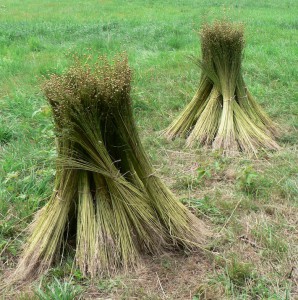
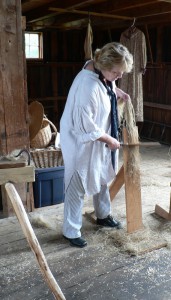
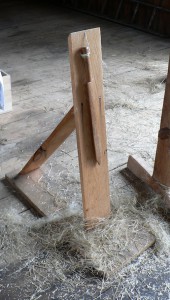
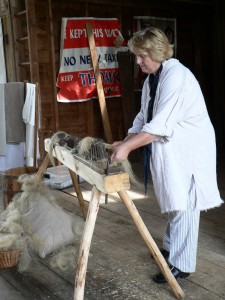
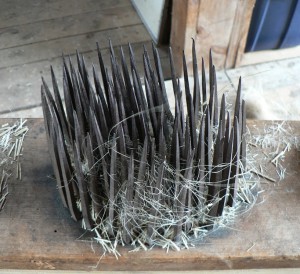
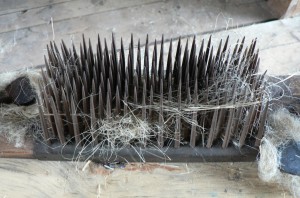
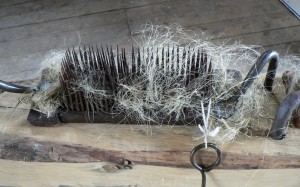
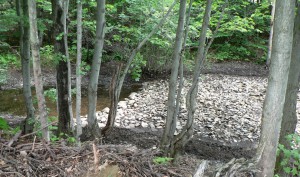
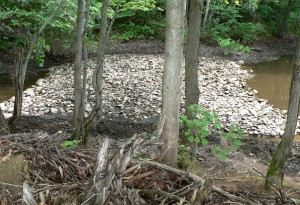
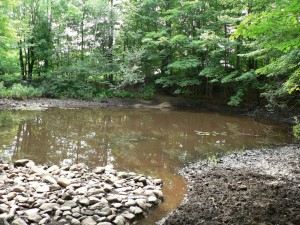
An excellent adventure indeed ! Thanks for writing about it. Also found the retting pond so interesting. Didn’t know they existed.